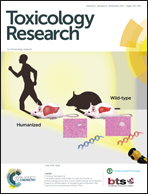Metabolomics for the early detection of cisplatin-induced nephrotoxicity†
Abstract
Cisplatin, which is an inorganic molecule containing a platinum ion, is an antineoplastic agent that has been used to treat various solid tumors. However, its side effects include nephrotoxicity, neurotoxicity, bone marrow toxicity, gastrointestinal toxicity, and ototoxicity, which can limit its use. In this study, nephrotoxicity was caused by the intraperitoneal injection of cisplatin into rats, and then metabolome analysis was performed using gas chromatography/mass spectrometry (GC/MS) and liquid chromatography/mass spectrometry (LC/MS) to find plasma metabolite biomarker candidates that would facilitate the early detection of cisplatin-induced nephrotoxicity. As a result, chronological changes were detected in the plasma levels of cysteine–cystine and 3-hydroxy-butyrate in the GC/MS-based metabolomics study. In the LC/MS-based metabolomics study, 3 acylcarnitines and a phosphatidylethanolamine with C18:2–C18:2 were identified as potential plasma biomarkers of cisplatin-induced nephrotoxicity. The plasma levels of these 6 metabolites altered significantly after the administration of cisplatin, and these alterations occurred quicker than the equivalent changes in the plasma levels of creatinine and blood urea nitrogen, which are usually used as indicators of renal dysfunction. These results indicate that the abovementioned metabolites might be reliable biomarkers that would allow the earlier detection of cisplatin-induced nephrotoxicity and that metabolomics is a useful tool for discovering biomarkers that could be used to predict the side effects of cancer therapy.



 Please wait while we load your content...
Please wait while we load your content...